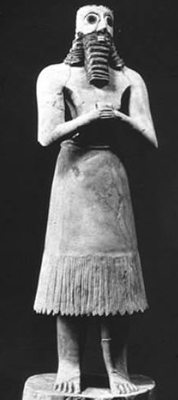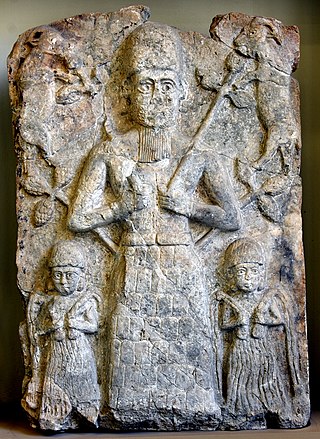Related Research Articles

Inanna is an ancient Mesopotamian goddess of love, war, and fertility. She is also associated with beauty, sex, divine justice, and political power. She was originally worshiped in Sumer under the name "Inanna", and later by the Akkadians, Babylonians, and Assyrians under the name Ishtar. She was known as the "Queen of Heaven" and was the patron goddess of the Eanna temple at the city of Uruk, which was her main cult center. She was associated with the planet Venus and her most prominent symbols included the lion and the eight-pointed star. Her husband was the god Dumuzid and her sukkal, or personal attendant, was the goddess Ninshubur.

Utu, also known under the Akkadian name Shamash, was the ancient Mesopotamian sun god. He was believed to see everything that happened in the world every day, and was therefore responsible for justice and protection of travelers. As a divine judge, he could be associated with the underworld. Additionally, he could serve as the god of divination, typically alongside the weather god Adad. While he was universally regarded as one of the primary gods, he was particularly venerated in Sippar and Larsa.
Belili was a Mesopotamian goddess. This name refers both to a sister of Dumuzi known from some of the texts pertaining to his death, and to a primordial deity paired with Alala and listed in enumerations of ancestors of Anu. There is no consensus among researchers if they should be considered one and the same.

Ninsun was a Mesopotamian goddess. She is best known as the mother of the hero Gilgamesh and wife of deified legendary king Lugalbanda, and appears in this role in most versions of the Epic of Gilgamesh. She was associated with Uruk, where she lives in this composition, but she was also worshiped in other cities of ancient Mesopotamia, such as Nippur and Ur, and her main cult center was the settlement KI.KALki.
Ninkasi was the Mesopotamian goddess of beer and brewing. It is possible that in the first millennium BCE she was known under the variant name Kurunnītu, derived from a term referring to a type of high quality beer. She was associated with both positive and negative consequences of the consumption of beer. In god lists, such as the An = Anum list and the Weidner god list, she usually appears among the courtiers of the god Enlil, alongside deities such as Ninimma and Ninmada. She could also be paired with Siraš, a goddess of similar character, who sometimes was regarded as her sister. A possible association between her and the underworld deities Nungal and Laṣ is also attested, possibly in reference to the possible negative effects of alcohol consumption.

Nanshe was a Mesopotamian goddess in various contexts associated with the sea, marshlands, the animals inhabiting these biomes, namely bird and fish, as well as divination, dream interpretation, justice, social welfare, and certain administrative tasks. She was regarded as a daughter of Enki and sister of Ningirsu, while her husband was Nindara, who is otherwise little known. Other deities who belonged to her circle included her daughter Nin-MAR.KI, as well as Hendursaga, Dumuzi-abzu and Shul-utula. In Ur she was incorporated into the circle of Ningal, while in incantations she appears alongside Ningirima or Nammu.
Lahar was a Mesopotamian deity associated with flocks of animals, especially sheep. Lahar's gender is a topic of debate in scholarship, though it is agreed the name refers to a female deity in a god list from the Middle Babylonian period and to a male one in the myth Theogony of Dunnu.

Ninshubur, also spelled Ninšubura, was a Mesopotamian goddess whose primary role was that of the sukkal of the goddess Inanna. While it is agreed that in this context Ninshubur was regarded as female, in other cases the deity was considered male, possibly due to syncretism with other divine messengers, such as Ilabrat. No certain information about her genealogy is present in any known sources, and she was typically regarded as unmarried. As a sukkal, she functioned both as a messenger deity and as an intercessor between other members of the pantheon and human petitioners.

Abu was a Mesopotamian god. His character is poorly understood, though it is assumed he might have been associated with vegetation and with snakes. He was often paired with the deity Gu2-la2, initially regarded as distinct from Gula, but later conflated with her.
Ningirida was a Mesopotamian goddess regarded as the wife of Ninazu and mother of Ningishzida. Little is known about her character beyond her relation to these two gods.
Azimua, also known as Ninazimua, was a Mesopotamian goddess regarded as the wife of Ningishzida.

Nungal, also known as Manungal and possibly Bēlet-balāṭi, was the Mesopotamian goddess of prisons, sometimes also associated with the underworld. She was worshiped especially in the Ur III period in cities such as Nippur, Lagash and Ur.

Geshtinanna was a Mesopotamian goddess best known due to her role in myths about the death of Dumuzi, her brother. It is not certain what functions did she fulfill in the Mesopotamian pantheon, though her association with the scribal arts and dream interpretation is well attested. She could serve as a scribe in the underworld, where according to the myth Inanna's Descent she had to reside for a half of each year in place of her brother.
Ashgi was a Mesopotamian god associated with Adab and Kesh. While he was originally the tutelary deity of the former of these two cities, he was eventually replaced in this role by his mother Ninhursag, locally known under the name Digirmah. He is mostly attested in sources from before the Old Babylonian period.

Sukkal was a term which could denote both a type of official and a class of deities in ancient Mesopotamia. The historical sukkals were responsible for overseeing the execution of various commands of the kings and acted as diplomatic envoys and translators for foreign dignitaties. The deities referred to as sukkals fulfilled a similar role in mythology, acting as servants, advisors and envoys of the main gods of the Mesopotamian pantheon, such as Enlil or Inanna. The best known sukkal is the goddess Ninshubur. In art, they were depicted carrying staffs, most likely understood as their attribute. They could function as intercessory deities, believed to mediate between worshipers and the major gods.
Dumuzi-abzu, sometimes spelled Dumuziabzu, was a Mesopotamian goddess worshiped in the state of Lagash. She was the tutelary deity of Kinunir.
Alla or Alla-gula was a Mesopotamian god associated with the underworld. He functioned as the sukkal of Ningishzida, and most likely was a dying god similar to Dumuzi and Damu, but his character is not well known otherwise. He had his own cult center, Esagi, but its location is presently unknown.

Ebiḫ (Ebih) was a Mesopotamian god presumed to represent the Hamrin Mountains. It has been suggested that while such an approach was not the norm in Mesopotamian religion, no difference existed between the deity and the associated location in his case. It is possible that he was depicted either in a non-antropomorphic or only partially antropomorphic form. He appears in theophoric names from the Diyala area, Nuzi and Mari from between the Early Dynastic and Old Babylonian periods, and in later Middle Assyrian ones from Assyria. He was also actively venerated in Assur in the Neo-Assyrian period, and appears in a number of royal Tākultu rituals both as a mountain and as a personified deity.
Bilulu was a Mesopotamian goddess who most likely functioned as the deification of rain clouds. She might be related to Ninbilulu known from a number of Early Dynastic texts. She is known from the myth Inanna and Bilulu, in which she is responsible for the death of Dumuzi. This event is subsequently avenged by Inanna, who turns Bilulu into a waterskin.
References
- 1 2 3 4 5 Krebernik 2003, p. 161.
- ↑ Krebernik 2003, p. 153.
- 1 2 3 Alster 2013, p. 436.
- 1 2 3 4 5 Lambert 2013, p. 388.
- ↑ Delnero 2020, p. 39.
- ↑ Lambert 2013, p. 525.
- 1 2 Krebernik 2014, p. 209.
- ↑ Lambert 2013, pp. 525–526.
- 1 2 3 4 5 6 7 Krebernik 2003, p. 162.
- ↑ Katz 2003, p. 364.
- ↑ Katz 2003, p. 151.
- ↑ Katz 2003, p. 137.
- ↑ Edzard 1971, p. 300.
- ↑ Wiggermann 2010, p. 330.
- 1 2 Katz 2003, p. 136.
- ↑ Katz 2003, p. 379.
- ↑ Katz 2003, p. 388.
- ↑ Katz 2003, p. 131.
Bibliography
- Alster, Bendt (2013), "Tammuz(/Dumuzi)", Reallexikon der Assyriologie, retrieved 2022-05-12
- Delnero, Paul (2020). How To Do Things With Tears: Ritual Lamenting in Ancient Mesopotamia. Studies in Ancient Near Eastern Records (SANER). De Gruyter. ISBN 978-1-5015-1294-0 . Retrieved 2022-05-12.
- Edzard, Dietz-Otto (1971), "Geštinanna", Reallexikon der Assyriologie (in German), retrieved 2022-05-12
- Katz, Dina (2003). The Image of the Netherworld in the Sumerian Sources. Bethesda, MD: CDL Press. ISBN 1-883053-77-3. OCLC 51770219.
- Krebernik, Manfred (2003). "Drachenmutter und Himmelsrebe? Zur Frühgeschichte Dumuzis und seiner Familie" (PDF). In Sallaberger, Walther; Volk, Konrad; Zgoll, Annette (eds.). Literatur, Politik und Recht in Mesopotamien: Festschrift für Claus Wilcke (in German). Wiesbaden: Harrassowitz. ISBN 3-447-04659-7. OCLC 51728225.
- Krebernik, Manfred (2014), "dTUR.TUR", Reallexikon der Assyriologie (in German), retrieved 2022-05-12
- Lambert, Wilfred G. (2013). Babylonian creation myths. Winona Lake, Indiana: Eisenbrauns. ISBN 978-1-57506-861-9. OCLC 861537250.
- Wiggermann, Frans A. M. (2010). "The image of Dumuzi. A diachronic analysis". Gazing on the deep: ancient Near Eastern and other studies in honor of Tzvi Abusch. Bethesda: CDL Press. ISBN 978-1-934309-26-1. OCLC 495996749.